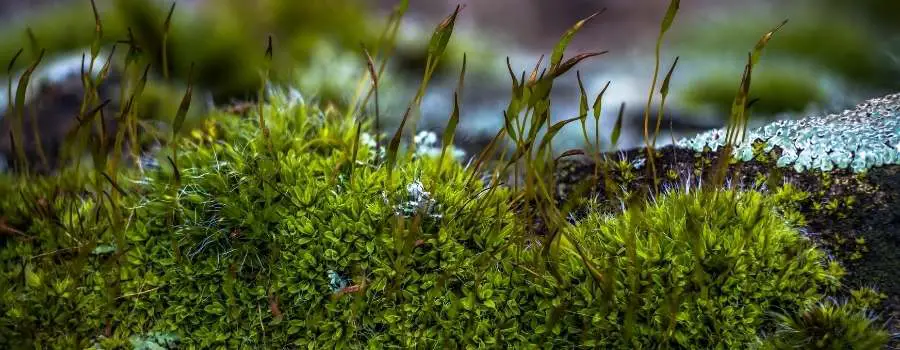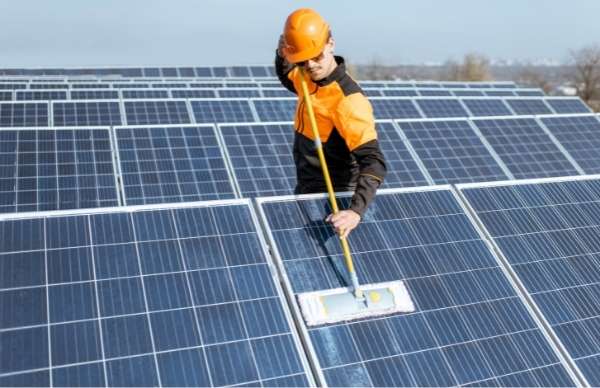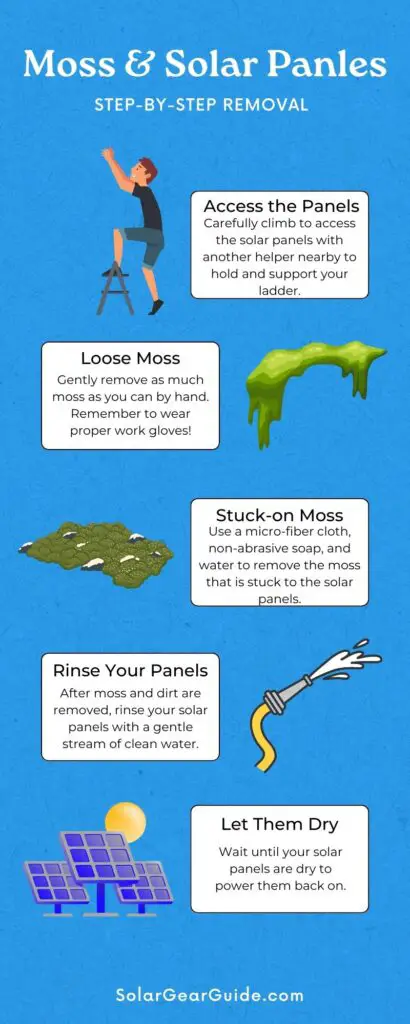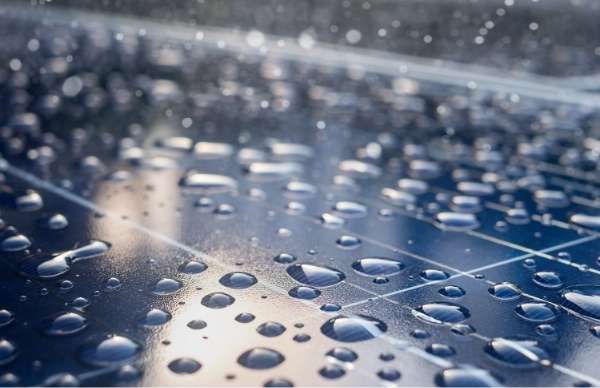
Solar panels are cutting-edge additions to homes, but there are things that homeowners might not be aware of when it comes to moss and solar panels.
That’s why I’m sharing some insights today on what you should know about preventing, removing, and cleaning moss from home solar panels.
Luckily this isn’t an issue new solar panel owners need to worry about, but after a year or two it’s not a bad idea to start keeping moss growth in the back of your head. So let’s jump in!
This article may contain affiliate links.
Moss And Solar Panels
Moss and solar panels is not a combination that mixes very well. Moss can pose significant challenges and drawbacks, diminishing their overall efficiency and performance.
While moss may be resilient and adaptable in nature, its growth on solar panels can have detrimental effects. Moss acts as an insulating layer, trapping moisture and preventing proper heat dissipation.
This leads to increased temperatures on the surface of the panels, resulting in reduced energy production and diminished overall efficiency of the solar panel system.
Moss growth can also create maintenance and cleaning issues. The delicate structure of moss can accumulate debris, dust, and other particles, further obstructing sunlight absorption and reducing the panel’s productivity.
Regular cleaning becomes necessary to prevent the buildup of moss and maintain optimal performance. This additional maintenance requirement not only increases the cost and effort associated with solar panel upkeep but also contributes to water consumption, which goes against the goal of eco-friendly and sustainable energy solutions.
Another concern with moss and solar panels is the potential for long-term damage. As moss spreads and establishes its root systems, it can penetrate and weaken the surface of the panels.
This can lead to cracks, leaks, and irreversible damage to the solar panel structure. The need for repairs or panel replacements due to moss growth adds to the financial and environmental costs of solar energy systems, undermining their overall benefits.
To mitigate the negative impact of moss on solar panels, preventive measures such as regular inspections and proactive cleaning practices are essential. Implementing strategies to minimize moisture retention and moss growth, such as improved panel design or coatings, can also help mitigate the risks associated with moss.
Always prioritize the maintenance and upkeep of solar panels to ensure optimal efficiency, extend their lifespan, and maximize the return on investment.
Does Moss Grow On Solar Panels?
Moss can grow on solar panels over time, which reduces output and compromises performance. To remove moss from panels, apply a roof moss killer in the fall and remove moss in the summer. To prevent moss growth, use products like Wet and Forget.
Moss…like other organic matter including lichen, algae, and mold…can start to grow on solar panels over time. Some people are under the impression that moss is something that only grows on other organic matter or natural objects. But this couldn’t be further from the truth.
Moss is a persistent, non-vascular, flowerless plant that can form if sunlight and dirt are present, followed by shade. Although the process won’t happen quickly – since moss can take several months to take hold – solar panels are just as prone to moss as trees, rocks, logs, and roofs are.
The reason moss grows on solar panels is that these devices can collect rainwater, particularly towards the bottom. Solar panels are usually situated at an angle, where gravity allows water to trickle down and pool up.
And, if you weren’t already aware, moist environments are ideal for moss growth – whether they’re natural environments or man-made ones like solar panels. Add a little bit of dirt and soil particles to that mixture – which gets blown onto solar panels in the wind – and you have a perfect recipe for this squishy plant to form.
Will Moss Affect My Solar Panels?
In general, moss can negatively affect the performance of solar panels by drastically lowering their power output. When moss growth is present, a solar panel can lose up to 50% efficiency if you don’t properly clean it.
Further, according to a study on Science Direct, opaque particle buildup (moss in particular) greatly affects solar PV performance and can reduce the power output by up to 86%.
Another way that moss affects solar panels is by becoming a location for more dirt, water, and particles to get trapped. Basically, moss leads to more moss and more opaque particles that reduce power output over time.
Moss and Solar Panels: How Moss Affects Solar Panel Lifespan
Moss buildup on panels can also be detrimental to longevity. Without regular cleaning to get rid of moss, you’re putting your solar panels at risk of a reduced lifespan. Normally, these devices can last anywhere between 25 and 30 years. That’s a pretty decent lifespan for a home renewable energy source.
However, the more you have to clean and remove moss, and the longer you wait to clean it, the more difficult it will be to leave the panels unscathed. This is because gentle cloths and products are the preferred tools for cleaning solar panels.
But if you have a difficult time removing moss, you may need to apply more abrasion to get a thorough cleaning. As a result, you can cause varying degrees of damage to your solar panels. Over time, this may lead to malfunction and the need for replacement.

How Do I Get Moss Off My Solar Panels?
The best way to get moss off of your solar panels is to get it professionally removed by a solar panel cleaning service. Since solar panels are located on roofs and in hard-to-reach locations, it can be incredibly dangerous to try and clean them yourself.
However, if you can’t afford or access professional moss removal services, you can do it yourself at home. Regular solar panel cleaning only really has to happen about once every year or two…usually in early spring and again in the fall. But for moss removal, you may want to clean more often since moss can take hold and grow in a shorter period of time…some species as quickly as 3-6 months.
Step-by-Step Moss Removal
Before you begin, make sure that you’ve chosen a day when the weather isn’t extremely hot and when it’s not raining. Then, shut down your solar panels by turning off the AC Isolator and Turning off the DC isolators.

To remove moss from your solar panels on your own, take the following steps with caution:
- Carefully climb to access the solar panels with another helper nearby to hold and support your ladder.
- Move to the areas of the solar panels that can support more weight (spots where mid clamps connect).
- Wearing gloves, begin removing the moss by hand, getting as much of it off as you can with this gentle method.
- Then, approach any moss residue still stuck to your panels by scrubbing.
- You’ll want to use something very gentle, like distilled water or dish soap with water, and a non-abrasive scrubbing tool (microfiber cloths work well).
- Once you have successfully removed the moss and scrubbed off dirt, particles, and residue, you can rinse the surface with pure water.
- Descend back to the ground with caution, making sure to dispose of the moss far away from your solar panels.
- Wait until your solar panels are dry to power them back on.
I’m stressing the importance of moss removal for proper solar panel maintenance.
Because moss inhibits solar panel output and efficiency so much, you need to know the best way to remove it.
This is especially true if you live in an already somewhat shady location or a region that doesn’t get as much direct sunlight.
Tips for Removing Moss
It’s important to note that when it comes to removing debris and moss from solar panels, the gentler you can be the better. Solar panel surfaces are incredibly delicate and can scratch easily. In general, plastic panels tend to be more durable than glass panels.

Therefore, you need to use gentle cloths (microfiber), dull tools (if you use any hard tools for scraping), and solutions and liquids that aren’t harsh. For delicate glass panels, you should stick to dish soap, vinegar, distilled water, and/or isopropyl alcohol (rubbing alcohol solution).
Vinegar is an especially useful cleaning agent when it comes to removing moss. This is due to the fact that the acetic acid content (like that in distilled white wine vinegar) can kill moss before you remove it. And if you’re going to try and kill the moss before removing it, do so in the fall, then wait until the spring to remove it.
It may also be helpful to have a waste bucket that you can hang on your arm so that you can collect the moss as you remove it.
How Do I Prevent Moss From Growing On Solar Panels?
You can prevent moss from growing on solar panels with a combination of moss-prevention products and regular cleaning. Generally, you only need to clean your solar panels about once a year, but if you experience a lot of moss build-up you will want to increase your cleaning schedule.
Regular Cleaning of Solar Panels
Especially if you live in an area that gets a lot of rain or shade, you should be cleaning your solar panels every few months. You can wait about six months, though, if your region is typically sunnier and dryer.
The reason that moss takes hold in the first place is that water settles on solar panels where dirt is. Then, the sun shines on this combination, leading to moss plant formation. So, if you’re regularly cleaning your solar panels, you reduce the dirt and water buildup, and thus, the possibility of moss formation.
Proper Placement of Solar Panels
Another way that you can try to prevent moss growth on solar panels is by positioning them correctly in relation to the sun. Since moss predominately grows on the north sides of trees, we can use that logic to assume it’s more likely to grow on the north sides of solar panels.
If you aren’t sure which way is north, pay attention to the sunset and sunrise patterns at your home. Use the rule of “the sun rises in the east and sets in the west” to figure out where north is. Or, you can use a handheld compass or compass on your smartphone to be more exact about the direction.
You’ll want to try and place your solar panel so that the glass isn’t facing north, if possible. Keep in mind, though, that proper placement to get an optimized amount of sunlight is most important, as that’s the whole point of the solar panels.
Furthermore, remember that moss can grow anywhere that there is moisture and a bit of soil. So, this isn’t a fail-proof method to prevent moss on solar panels.

Check on Moisture Regularly
Finally, I want to stress the importance of keeping your solar panels dry and clear of standing rainwater.
I suggest regularly wandering up to your solar panels (with caution) to see if water has run down and built up at the base without drying. If so, it might be worth it to shut off your solar panels temporarily so that you can dry them off with a gentle, soft towel.
Another aspect of moisture that you should pay attention to is the moisture that’s getting on your solar panels from their surroundings. For example, are your solar panels positioned beneath treetops or downwind of branches that could be slowly dripping water onto them, which builds up?
If so, you might want to consider repositioning your solar panels so that they aren’t at such a high risk of being overtaken by moss.
Can You Use Wet And Forget On Solar Panels?
In general, products such as Wet and Forget work well to help clean moss off your solar panels and to help prevent moss from growing. Alkyl dimethyl benzyl ammonium chloride (Benzalkonium chloride) is the active ingredient that helps prevent living organisms such as moss from growing.
Wet and Forget, or similar products, is one of the consumer solutions you can use to help prevent some of the buildup of living organisms on your solar panels.
What Is Wet and Forget?
Wet and Forget is a gentle formula for cleaning organic growth off of outdoor surfaces. It is free of harsh chemicals, such as bleach, that are too intense for the glass of solar panels. What’s particularly useful about Wet and Forget is that it’s a spray-on solution that works almost by itself.
It doesn’t typically require any kind of after rinse, as it relies on the wind and rain to clean surfaces like solar panels. In fact, on the Wet and Forget website, the company even recommends using this product for cleaning solar panels and preventing the growth of moss.
How to Use Wet and Forget
To use Wet and Forget, wait until you’re prepared to safely clean your solar panels. This means shutting off the power before you start and taking the safety precautions I mentioned earlier.
Do so on a dry day that isn’t too hot…preferably a day or so before some rain is expected to arrive in your area.
You either get the hose-end sprayer to hose this formula onto your solar panels with more pressure. Or, you can apply it with a spray nozzle or spray bottle.
Final Thoughts
When it comes to moss and solar panels, remember to make sure to consider the maintenance and cleaning involved in using home solar panels. Basically anywhere that dirt and water build-up can become a breeding ground for moss plants.
Because of this, solar panels need to be cleaned regularly with gentle products and sprayed with moss-preventatives like Wet and Forget. Make sure to keep my tips in mind for proper cleaning and moss removal on solar panels. And try out some of my tips for proper solar panel placement to prevent moss growth. Best of luck!
